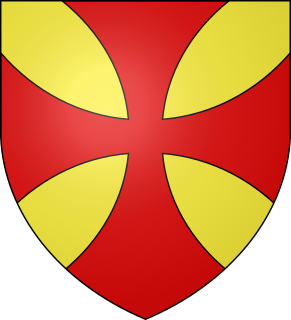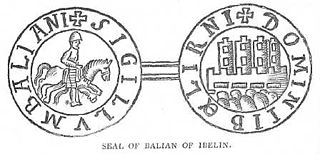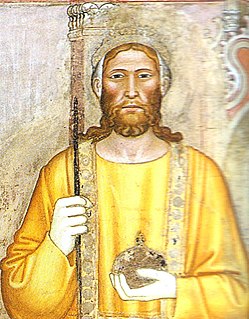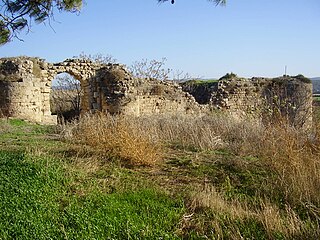
Aimery of Lusignan, erroneously referred to as Amalric or Amaury in earlier scholarship, was the first King of Cyprus, reigning from 1196 to his death. He also reigned as the King of Jerusalem from his marriage to Isabella I in 1197 to his death. He was a younger son of Hugh VIII of Lusignan, a nobleman in Poitou. After participating in a rebellion against Henry II of England in 1168, he went to the Holy Land and settled in the Kingdom of Jerusalem.

The Kingdom of Cyprus existed between 1192 and 1489. It was ruled by the French House of Lusignan. It comprised not only the island of Cyprus, but also had a foothold on the Anatolian mainland: Antalya between 1361 and 1373, and Corycus between 1361 and 1448.
Hugh III of Cyprus, born Hugues de Poitiers, later Hugues de Lusignan, called the Great, was the King of Cyprus from 1267 and King of Jerusalem from 1268. He was the son of Henry of Antioch and Isabelle de Lusignan, the daughter of king Hugh I of Cyprus. He was a grandson of Bohemund IV of Antioch and thus a descendant of Robert Guiscard.

The Crusader state of the Kingdom of Jerusalem, created in 1099, was divided into a number of smaller seigneuries. According to the 13th-century jurist John of Ibelin, the four highest crown vassals in the kingdom proper were :

There were six major officers of the kingdom of Jerusalem: the constable, the marshal, the seneschal, the chamberlain, the butler and the chancellor. At certain times there were also bailiffs, viscounts and castellans.

The House of Ibelin was a noble family in the Crusader Kingdom of Jerusalem in the 12th century. They rose from humble beginnings to become one of the most important families in the kingdom, holding various high offices and with extensive holdings in the Holy Land and Cyprus. The family disappeared after the fall of the Kingdom of Cyprus in the 15th century.

Balian of Ibelin, also known as Barisan the Younger, was a crusader noble of the Kingdom of Jerusalem in the 12th century. He was lord of Ibelin from 1170-1193. As the leader of the defense of the city during the siege of Jerusalem in 1187, he surrendered Jerusalem to Saladin on October 2, 1187.

John of Ibelin, called the Old Lord of Beirut, was a powerful crusader noble in the 13th century, one of the best known representatives of the influential Ibelin family. The son of Balian of Ibelin and Maria Comnena, Queen consort of Jerusalem, he had close ties with the nobility of both Cyprus and Jerusalem, since he was the half-brother of Queen Isabella I of Jerusalem. Before he was 20, he was appointed constable of Jerusalem, and a few years later became lord of Beirut, where he rebuilt the city after Saladin's conquest, and established the grand Ibelin family palace. He served as regent for two of his young relatives, Isabella's daughter Maria of Montferrat from 1205 to 1210, and then Henry I of Cyprus from 1228 until Henry came of age in 1232. John was known as a principled man, and was seen as the natural leader of the Christian barons in the Holy Land. He resisted the power-seeking of Frederick II, Holy Roman Emperor, in Cyprus, and opposed the imperial forces until Henry came of age.

Peter I of Cyprus or Pierre I de Lusignan was King of Cyprus and titular King of Jerusalem from his father's abdication on 24 November 1358 until his death in 1369. He was the second son of Hugh IV of Cyprus, the first by his second wife Alice of Ibelin. He was also invested as titular Count of Tripoli when young, in 1346. As King of Cyprus where he had military successes, but he was unable to complete many plans, due to internal disputes that culminated in his assassination at the hands of three of his knights.
The Kingdom of Cyprus, as an offshoot of the Kingdom of Jerusalem, maintained many of the same offices, such as: seneschal, constable, marshal, admiral, Chamberlain, and chancellor.
Roger of San Severino was the bailiff of the Kingdom of Jerusalem from 1277 to 1282. He was sent to Acre, then the capital of the kingdom, with a small force by the new king Charles I, also King of Sicily, to act as regent.

Balian III of Beirut was the Lord of Beirut, the second of his family, from 1236, and a son of the famous "Old Lord" John of Ibelin, by his second wife Melisende of Arsuf. From his father he assumed the leadership of the nobility in the War of the Lombards, fought against the agents of the Emperor Frederick II.

Baldwin of Ibelin was the fourth of five sons of John I of Beirut and his second wife Melisende of Arsuf.

Guy of Ibelin, of the Ibelin family, was Count of Jaffa and Ascalon during the latter part of the Crusades. He was the son of John of Ibelin and Maria of Barbaron. He was Count in name only. His father, John of Jaffa, had died in 1266, after which the fragile truce with the Muslims collapsed, and Jaffa was captured by Baibars in 1268. John was probably succeeded by Guy's older brother James, who held the title of Count of Jaffa until his death in 1276, at which point the title passed to Guy.

Guy of Ibelin was marshal and constable of the kingdom of Cyprus. He was the fifth son of John of Ibelin, the Old Lord of Beirut, and of Melisende of Arsuf. He had close relations with the king of Cyprus, Henry I, acting as witness for two royal decrees; he was probably one of the king's executors named in a papal bull of Pope Alexander IV. With his brother Baldwin of Ibelin, he led the Cypriot crusaders in the siege of Damietta in 1248. According to the medieval chronicler Jean de Joinville, he was one of the most accomplished knights of his generation and a benevolent ruler on Cyprus. Joinville recounts an episode when he, Guy and Baldwin had been taken prisoner by saracen rebels:
I asked the lord Baldwin of Ibelin, who knew the saracen tongue well, what the men were saying. He answered that they were talking about cutting off our heads. Many men then made confession to a brother of the Holy Trinity, named John, belonging to the retinue of count William of Flanders. I could not think of a single sin. At the same time I was thinking that the more I defended myself the worse it would be. Then I crossed myself and knelt at the foot of a Saracen, who had a Danish axe in his hand, saying,"Thus was St Agnes killed." Guy of Ibelin, constable of Cypress, knelt beside me and made his confession to me. I answered him: "I grant you absolution by the power God has given me." But when I got up, I could not remember what he had said or told me.

Melisende was the hereditary Lady of Arsuf from 1177 and the second wife of the powerful nobleman John of Ibelin, the lord of Beirut (1179–1236), who led the opposition to Emperor Frederick II when he tried to impose his authority in the Kingdom of Jerusalem and the Kingdom of Cyprus.

John was the Lord of Caesarea from 1229 and an important figure in the kingdoms of Cyprus and Jerusalem. He was the only son of Walter III of Caesarea and Marguerite d'Ibelin, daughter of Balian of Ibelin. He was often called "the young lord of Caesarea" throughout his life to distinguish him from his father, who had been called "the old lord of Caesarea".

Philip of Ibelin (1180-1227) was a leading nobleman of the Kingdom of Cyprus. As a younger son of Balian of Ibelin and the dowager queen Maria Komnene, he came from the high Crusader nobility of the Kingdom of Jerusalem.
Akaki Castle, also known as the Tower of the Franks is a castle in Cyprus. It served as a retreat for the kings of Cyprus.
Guy II or Guido II, surnamed Embriaco, was the lord of Gibelet from about 1271 until his death.









